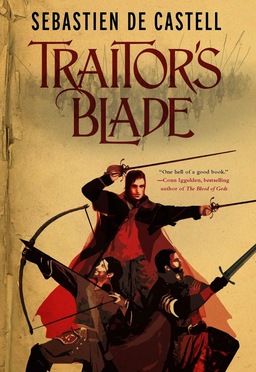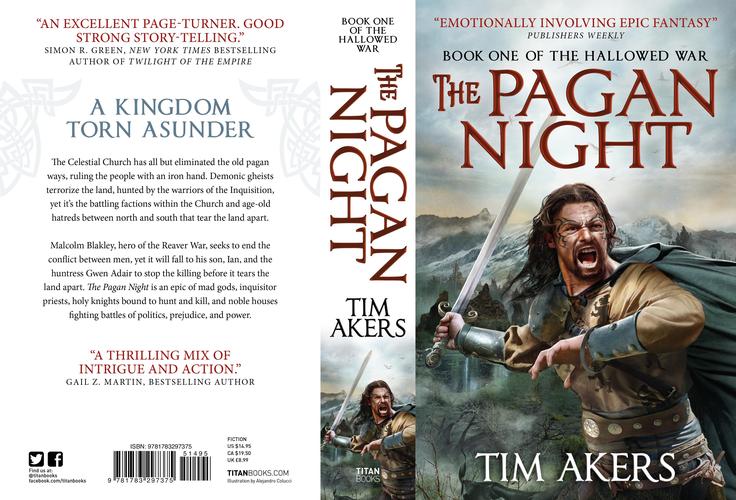The Series Series: The Pagan Night by Tim Akers
It’s a tempting mistake to see The Pagan Night as an attempt to pare George R.R. Martin’s A Song of Ice and Fire series down to a more manageable scale. At first glance, the setting appears to be an old-school medieval European fantasy world with knights, peasants, heraldry, tournaments, and dark forests full of monsters.
Those dark forests are where Akers gets up to some impressive hijinks.
You may know the old saw about how a conquered people’s gods will become their conquerors’ demons. Akers takes that mythological observation and gives it a literal, visceral physicality that owes more to Miyazaki’s brilliant Princess Mononoke than to anything out of European myth or folklore. The novel’s conquered Tenerrans are animists — their customs look like those of European tribes, but their worldview seems to owe its greatest debt to Shinto.
But here’s a divergence: what happens to the gods who arise on their own from the natural world, now that the human rites that managed relations with them are outlawed? The gods go feral, mad, destructive. They must be killed again and again, only to come back again and again, always less like their old selves… until maybe they don’t anymore, and the land begins to die. Unless they can be protected in secret by the faithful.
And what of those other faithful, of the conquerors’ church? To my surprise, the church in Akers’s Tenumbra resembles nothing so much as certain branches of modern Neo-Paganism: a bright goddess of summer, balanced in partnership with a protective god who dies and comforts the dead in winter. Organization is what makes a church a church, and dispersed grass-rootsiness is what makes a faith that of i pagani, the people of the countryside. The clerics dedicated to Lord Cinder and Lady Strife are protectors of the cities and towns, protectors of the human world from the wild. The vow knights of Lady Strife are walking doomsday weapons of solar fire, the monks of Lord Cinder devious spirit mages of smoke and shadow. I’d put my walled city in their care any day.
Akers gives us a mixed cast of knights and clerics, men and women, conquered northern Tenerrans and conquering southern Suhdrins, devout animists and duotheists — as well as freethinkers, spiritual slackers, and hackers of the entire sacred cosmos. One remarkable thing about this cast is that it precisely doesn’t feel like a Busby Berkeley cast of thousands. Akers keeps a tight grip on which characters get to share their viewpoints with the reader. Readers who suffer from GRRM fan fatigue will probably find this disciplined focus welcome. Personally, I would have liked to see a little more organic sprawl, and more variety in the characters’ social status, but then I’m on the record as an advocate for the things that only sprawling books can do.
Akers gives us two northern families who have adapted to the conquest of their land in completely different ways. Each family has its reckless but good-hearted young heir, its canny elders, and its deep sense of responsibility for the smallfolk. But there the similarities end.
Malcolm Blakley, hero of the land’s last war, embraces the new faith with a bone-deep earnestness, while there are those in House Adair who pledge themselves in secret to keep one great land spirit sane and strong as if the life of the land depends on it. Both kinds of faithful fear the church’s Inquisition — everyone does, even some of the Inquisitors.
The charming heirs of both families want desperately to be worthy protectors of their people. Gwen Adair and Ian Blakley blunder and mature their way through the book in a madrigal counterpoint with one another, and with their parents’ preparations to give all that they are and all that they cherish for their respective faiths.
 The vow knight Sir Elsa LaFey at first appears to be a woman warrior out of central casting, but I think that impression is mostly a result of her name. The power that manifests through her is vaster than her early foes stand any chance against, but that same power burns her. She’s accepted that the goddess she serves will cut her life short, because that’s what it takes to protect the human world from forces that would destroy it. The world’s fate turns, at one point, on how she interprets her vows. How that interpretation will play with the other vow knights, we will have to wait to see.
The vow knight Sir Elsa LaFey at first appears to be a woman warrior out of central casting, but I think that impression is mostly a result of her name. The power that manifests through her is vaster than her early foes stand any chance against, but that same power burns her. She’s accepted that the goddess she serves will cut her life short, because that’s what it takes to protect the human world from forces that would destroy it. The world’s fate turns, at one point, on how she interprets her vows. How that interpretation will play with the other vow knights, we will have to wait to see.
Her traveling companion, Frair Lucas, comes paradoxically close to enlightenment, for a servant of a god who manifests in smoke and darkness. He’ll follow the truth-seeking precepts of Lord Cinder wherever they lead. He’s a grizzled old man, physically frail, and an utter magely badass. Akers has given Lucas a sense of humor about his own apparent contradictions, and that wry subtlety leavens a great many of the books grim moments.
As for the military and historical accuracy of the scenes of battle and tournament, I’m not the best person to ask. I can say, though, that the years of research I’ve done to try to be a worthy writer of such scenes, myself, lead me to think well of Akers. The Tenerran horses refuse all commands to cross bramble hedges, spook and flee in the presence of monstrous gods, and sometimes die when their humans must drive them beyond their endurance. Tenerran armor bends under blows and pinches the bodies it’s meant to shield. Weapons are nearly as difficult for the people dealing blows as for the people receiving them. And armies must move or starve, if they are not to strip bare the country they fight for.
I don’t know whether this series will become a landmark of the genre. With Sebastien de Castell’s Greatcoats series and M.H. Boroson’s The Girl with Ghost Eyes, I knew with the first volume that, if later volumes kept up the quality, we’d have classics on our hands. With Tim Akers’s The Hallowed War, I’d want to see the next volume exceed the high mark set in The Pagan Night. But he would not have to exceed it by far, and I’m pretty sure he’ll pull it off. Whether he does or not, this first novel is just about the perfect book for readers of Black Gate. Badass warriors, all kinds: check. Monsters: check. Dangerous magics: check. Secret passages in ancient castles: double check. Does stuff happen? It does, a lot of it, in rapid succession and with shiny surprises.
Sarah Avery won the 2015 Mythopoeic Fantasy Award for her novella collection, Tales from Rugosa Coven. The Trafficking in Magic, Magicking in Traffic anthology she coedited with David Sklar includes stories by James Enge, Elizabeth Bear, and Darrell Schweitzer. Her own short stories have appeared Jim Baen’s Universe, Fantasy Scroll Magazine, and the last print issue of Black Gate. Sarah’s an escaped academic who survived earning a Ph.D. in English literature, and an ambivalently entrepreneurial private tutor. Her Kickstarter project, The Imlen Bastard, will be available this summer. You can keep up with her at her website, sarahavery.com and follow her on Twitter.

Sounds interesting. Was put off a bit by the ugly cover art. Think I need to give this one a shot.